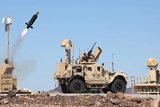How do we detect and defeat enemy drones?
Learn about the portfolio of sensors and effectors for the complete counter-UAS mission at Raytheon, an RTX business.
Using capabilities across all domains NATO hopes to get a much more complete and accurate ISR picture (Northrop Grumman)
NATO’s future surveillance capability is set to be radically different from its existing Airborne Warning and Control System (AWACS) aircraft.
The ageing 14 E-3A Sentry AWACS are set to be replaced by 2035 with a new system-of-systems that will include a mix of manned and unmanned airborne platforms networked with space, ground and maritime assets. These will be introduced under the Alliance Future Surveillance and Control (AFSC) project.
Due to the complexity of AFSC, the NATO Support and Procurement Agency (NSPA) has awarded three separate industry teams a €15.5 million ($17.08 million) contract each for the Risk Reduction and Feasibility Studies
Already have an account? Log in

Learn about the portfolio of sensors and effectors for the complete counter-UAS mission at Raytheon, an RTX business.

The US-based tests successfully demonstrated the first live trial of a precision guided missile from a modified TRV-150 drone which destroyed both aerial and ground targets.

India’s stealth fighter ambitions gain fresh momentum as HAL opens the door to private sector involvement in AMCA Mk1A structural assembly, with strategic support growing for next-gen propulsion and sensor technologies.

A key part in the trinational Global Combat Air Programme (GCAP), this is the first crewed supersonic aircraft demonstrator to be built and developed in the UK in more than 40 years.

Kratos’ XQ-58A Valkyrie will be equipped with an Airbus-made mission system to be offered as a ‘European’ collaborative combat aircraft option to the German Air Force.

The munitions variant of the Barrauda-100 autonomous air vehicle is being tested for the US Army’s High-Speed Manoeuvrable Missile (HSMM) testbed programme, with further flight tests expected in 2026.